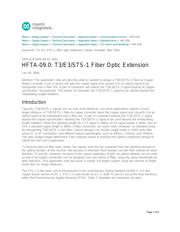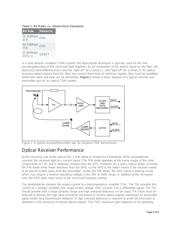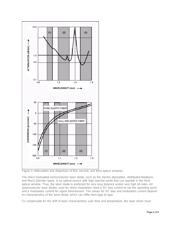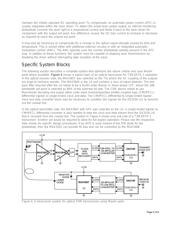下载

Maxim > Design Support > Technical Documents > Application Notes > Communications Circuits > APP 2931
Maxim > Design Support > Technical Documents > Application Notes > Optoelectronics > APP 2931
Maxim > Design Support > Technical Documents > Application Notes > T/E Carrier and Packetized > APP 2931
Keywords: T3, E3, STS-1, fiber optic extension, media converter, fiber, fibre
APPLICATION NOTE 2931
HFTA-09.0: T3/E3/STS-1 Fiber Optic Extension
Jan 05, 2004
Abstract: This application note will describe what is needed to design a T3/E3/STS-1 Fiber to Copper
Media Converter. Such a device will take the copper signal and convert it to an optical signal to be
transported over a fiber link. A pair of converters will extend the T3/E3/STS-1 signal beyond its copper
specification, transparently. This allows, for example, the T3/E3/STS-1 signal to be utilized beyond the
intrabuilding length limitation.
Introduction
Typically, T3/E3/STS-1 signals are run over short distances, but some applications require a much
longer distance. A T3/E3/STS-1 fiber-to-copper converter takes the copper signal and converts it to an
optical signal to be transported over a fiber link. A pair of converters extends the T3/E3/STS-1 signal
beyond the copper specification, allowing the T3/E3/STS-1 signal to be used beyond the intrabuilding
length limitation. While the standard length for a T3 signal is 380m, an E3 signal length is 440m, and an
STS-1 standard signal length is 360m, a fiber connection can reach miles. However, no standard exists
for transporting T3/E3/STS-1 over fiber. Typical designs can include single-mode or multi-mode fiber
using SC or ST connectors, and different optical wavelengths, such as 850nm, 1310nm, and 1550nm.
The optic budget length determines if the engineer needs to enhance the optical component design to
satisfy the end user's application.
To transmit data via fiber optic cables, the signals must first be converted from the electrical domain to
the optical domain. At the receiver, the process is reversed. Most designs use two fiber strands for each
direction: Tx and Rx. However, because of the unique properties of light, an optical diplexer can be used
so that a full-duplex connection can be designed over one strand of fiber, using the same wavelength for
both directions. This application note discusses a simple, full-duplex system using two strands of single-
mode fiber for longer distances.
The STS-1 is the basic unit of transmission in the Synchronous Optical Network (SONET). It is the
copper-based version of OC-1. STS-1 is also known as EC-1. Both T3 and E3 are at the third hierarchy
within the Plesiochronous Digital Hierarchy (PDH). Table 1 illustrates the respective bit rates.
Page 1 of 6








